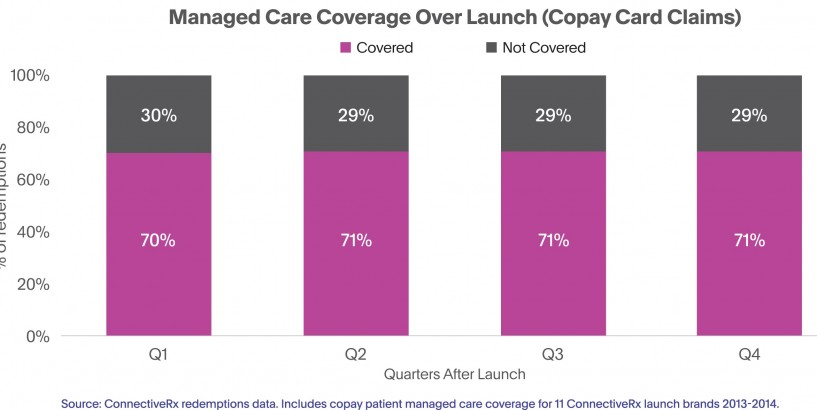Along with their specialty brand counterparts, retail brands are starting to experience the pain of more restrictive launch and ongoing access challenges, including NDC blocks, step edits, prior authorizations, and ever-increasing copays. In response, retail brand teams are increasingly deploying hub services access strategies formerly associated with specialty brands, including electronic benefit verification (eBV) services, electronic prior authorization (ePA) processing, and electronic PA appeals support.
Houston, We Have a Problem In the “good old days” of pharma marketing—five to six years ago—retail brand access was strong right out of the gate. Our team recently examined managed care coverage for 11 retail brand launches in 2013-14 (see Figure 1). Believe it or not, 70% of pharmacy claims for these brands were covered in month one, and the coverage rate remained essentially stable throughout the entire 12 months post launch.
Historically, brands were often covered for the first six months to a year while the payers reviewed the brand’s clinical data, assessed market demand, and negotiated a rebate contract with the manufacturer. Today, however, retail brands face significant access headwinds right at launch. Payers use PAs, step edits, non-formulary NDC statuses, or other administrative rejections to control access. For 10 retail brand launches in the past two years, access at month one was just 43%, and took six months to crack 60% (Figure 2). Even after 12 months, access never reached 70%.
Cutting the Pain of High Deductible Health Plans Even when brands are covered at launch, patients face the challenge of substantially increased copays in both traditional plans and high-deductible health plans (HDHPs). According to the latest Employer Health Benefits Survey from the Kaiser Family Foundation, the percentage of covered workers enrolled in a plan with a general annual deductible of $1,000 or more for single coverage reached 58% in 2018, more than double the percentage in 2010 (27%). With the rapid expansion of HDHPs, copays have risen even more dramatically. Starting in about 2015, patients have faced substantially higher retail brand copays year over year. Fortunately for patients, retail brand manufacturers have managed to keep actual out-of-pocket costs reasonably steady by providing more generous copay offsets.
How Hubs Help Level the Payer Battlefield In order to level the battlefield with payers, many retail brand teams are turning toward powerful access strategies that were formerly reserved for specialty brands: Hub services. Traditional hub services include benefits investigation and verification, prior authorization (PA) management, drug delivery and administration support, copay program enrollment, financial assistance, and patient education. Traditional hub services begin with a call center and are typically used by specialty brands with complicated distribution, access, affordability, and adherence needs. The combination of technology, deeply experienced case managers, and analytics can help smooth the patient journey for many specialty brands.
While most retail brands don’t leverage a complete array of hub services, many can benefit from new, targeted, technology-enabled versions of hub services that are core to a brand’s launch and ongoing success. Selectively deploying these emerging capabilities can help mitigate access challenges, improving a brand’s gross to net. These include eBV services, ePA processing, and electronic PA appeals support. Each of these is highlighted briefly below:
eBV provides insight into:
Formulary status, including covered/not covered, tier, etc. Coverage details, including age and quantity limits, step edits, prior authorization, etc. Medication supply options, including 30-day/90-day options, retail, mail-order, etc. Patient Out of Pocket cost information ePA enables electronic submission and a real-time approval process:
Patient and drug information submitted to payer Criteria provided by payer specific to the patient and the drug requested Completed criteria submitted to the payer Determination returned to provider with a faster turnaround time Electronic PA appeals support speeds the process for HCPs and patients:
Electronic submission (if the payer supports) Expiration date to appeal, appeal note Question set with ability to attach support documentation These new technology-based solutions are typically modular, thus giving the brand the flexibility to provide the services most needed by HCPs and patients.
Which retail brands should incorporate hub services into launch planning?
Experience shows that these specialized hub services are a good fit for high-value retail brands that…
Want to preserve prescriber choice Need innovative ways to mitigate utilization management strategies (such as Prior Authorization) Anticipate NDC blocks, step edits, or coverage challenges Expect high primary script abandonment, having earned the script but losing it along the patient journey Anticipate adherence challenges How retail launch brands and their patients benefit from technology-enabled hub services
An integrated solution (copay + hub) helps patients overcome barriers to get on therapy, and reduces patient benefit costs. Helps patients access and afford crucial therapy, including identification of relevant copay offers, bridge program management, and appeals support. Enhances patient-provider communication and increases engagement with brand. Offers expanded market intelligence and monitors changes in market access in real time. Bottom line: Carefully selected technology-enabled hub services for retail launch brands can help prescribers preserve their choice and help patients get on and stay on new to market therapies quickly and effectively.









